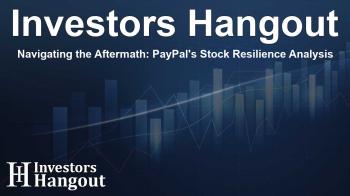Navigating the Aftermath: PayPal's Stock Resilience Analysis

Understanding PayPal's Stock Performance
Payments giant PayPal (NASDAQ: PYPL) has begun the year on a challenging note, facing shrinking stock values. The significant drop, nearing 11%, as of a recent market close, has sparked discussions amongst investors. Many contend that the level of decline in PayPal’s shares is unwarranted, especially in light of the company’s latest earnings report.
This report, disclosed in early February, revealed that PayPal surpassed expectations on revenue and adjusted earnings per share (EPS). Yet, despite these positive financial metrics, shares plummeted by over 13% in just one trading session. This raises a critical question: Is this downturn a golden opportunity for savvy investors, or does it signal a downward trend in PayPal’s future?
Analyzing Key Metrics Behind Investor Concerns
Investor apprehension largely centers around a vital segment of PayPal’s operations known as branded checkout. This feature allows online retailers to offer their customers a seamless payment experience through PayPal, making transactions quicker and easier.
With branded checkout, registered users can complete purchases without the hassle of entering lengthy credit card details. This convenience boosts sales for merchants, even though PayPal takes a percentage of these transactions. However, the growth in payment volume from branded checkouts increased by only 6%, falling short of market expectations. PayPal's CEO had previously termed branded checkout as the firm's top priority, making this underperformance a point of concern amongst investors.
Furthermore, PayPal observed a notable slowdown in its unbranded payment processing service, Braintree, which saw growth tumble from 29% to just 2%. Despite this decline, PayPal reported improvements in profitability by prioritizing services that yield better margins over mere growth.
The Market's Perspective on PayPal's Strategy
The current market sentiment appears to favor rapid growth over the profitability focus that PayPal is embracing. This dissonance between PayPal’s objectives and market expectations may indicate potential short-term challenges ahead for the stock.
However, a key strength of PayPal that cannot be overlooked is its robust free cash flow generation. The company anticipates generating about $6.5 billion in free cash flow for the upcoming fiscal year, leading to a forward price-to-free cash flow ratio of nearly 12x. This valuation is significantly lower than that of many competitors, but PayPal’s growth rate has been slower than others in the space, stirring apprehension regarding its competitive position.
Despite the looming concerns, PayPal retains a dominant market share based on statistical insights, which presents a promising foundation for recovery. The overall investor outlook reflects mixed reactions, with a blend of analysts adjusting their price targets after the recent earnings call. The average price target reached around $97 per share, suggesting a potential upside of 27% from the current levels.
Final Thoughts on PayPal's Market Standing
PayPal stock currently stands at a crossroads between perceived risk and reward. Its persistent focus on long-term profitability is often overshadowed by immediate growth concerns. As the company prepares for its Investor Day event, investors will be keenly watching for updates on strategic initiatives and progress toward long-term goals.
In summary, while the market reacts to short-term setbacks, PayPal's solid cash flow and market positioning may offer significant opportunities for those looking beyond current challenges. Ultimately, it’s pivotal for investors to assess both the potential risks and long-term prospects associated with PayPal.
Frequently Asked Questions
What caused the recent drop in PayPal's stock price?
The drop is attributed to a mix of disappointing growth metrics in key payment processing areas despite beating revenue expectations.
Is PayPal still considered a good investment despite the downturn?
Many analysts believe PayPal represents a solid risk-reward opportunity due to its strong cash flow and market share.
How does PayPal's growth compare to its competitors?
PayPal's growth has been slower compared to some competitors, raising concerns about its competitive position in the payment processing sector.
What are analysts predicting for PayPal's future stock performance?
Analysts have set an average price target of $97 per share, indicating a potential upside of 27% based on current valuations.
What should investors watch for regarding PayPal's strategy?
Investors should pay attention to updates from PayPal’s upcoming Investor Day and any developments around its long-term profitability goals.
About The Author
Contact Owen Jenkins privately here. Or send an email with ATTN: Owen Jenkins as the subject to contact@investorshangout.com.
About Investors Hangout
Investors Hangout is a leading online stock forum for financial discussion and learning, offering a wide range of free tools and resources. It draws in traders of all levels, who exchange market knowledge, investigate trading tactics, and keep an eye on industry developments in real time. Featuring financial articles, stock message boards, quotes, charts, company profiles, and live news updates. Through cooperative learning and a wealth of informational resources, it helps users from novices creating their first portfolios to experts honing their techniques. Join Investors Hangout today: https://investorshangout.com/
The content of this article is based on factual, publicly available information and does not represent legal, financial, or investment advice. Investors Hangout does not offer financial advice, and the author is not a licensed financial advisor. Consult a qualified advisor before making any financial or investment decisions based on this article. This article should not be considered advice to purchase, sell, or hold any securities or other investments. If any of the material provided here is inaccurate, please contact us for corrections.

